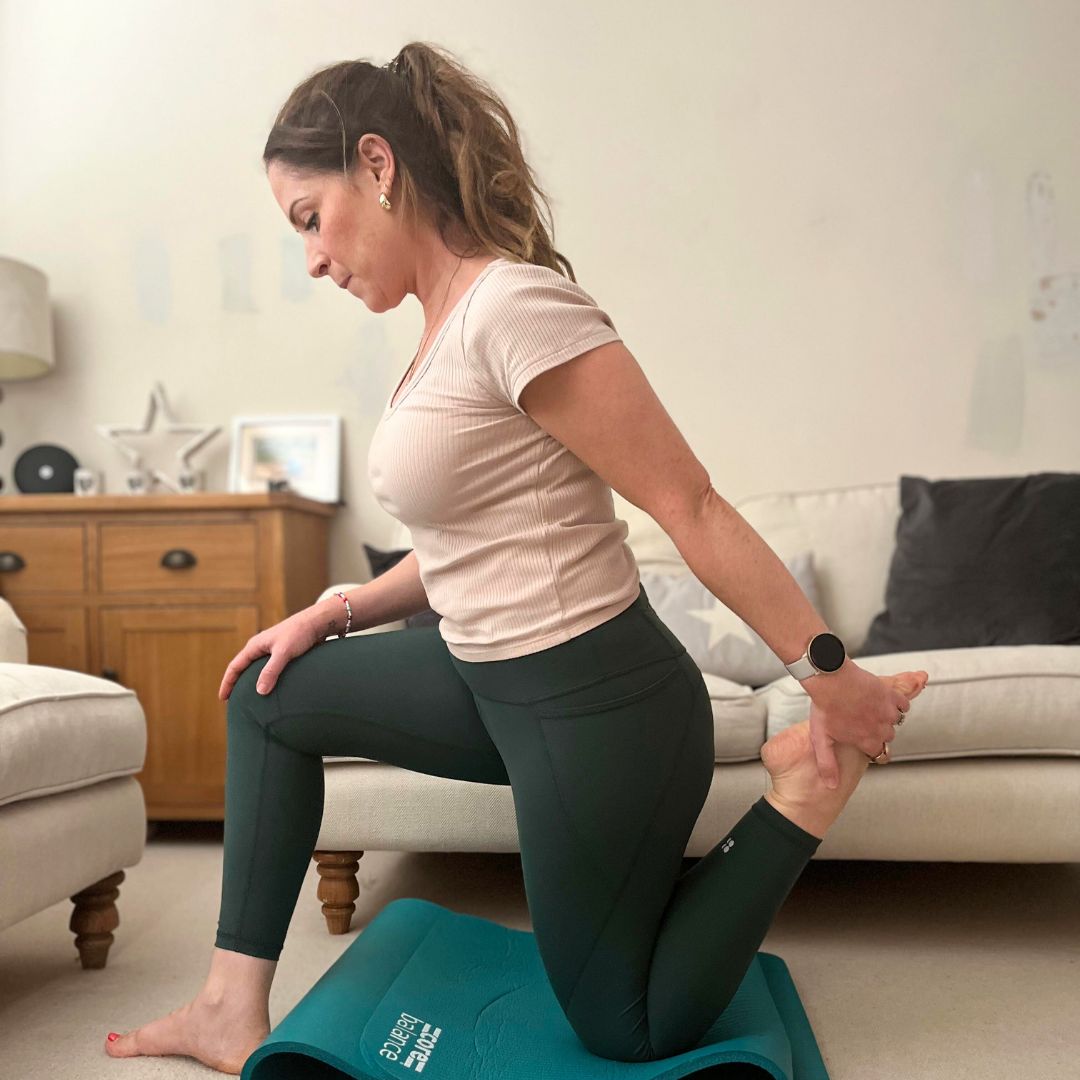
Seen the trending shrimp challenge on your TikTok? Before you get excited about platters of seafood, let us explain. A new viral fitness challenge that sadly doesn't include rose-fuelled afternoons by the sea isn't a workout, per se, rather an indicator of your current fitness level. And I'll tell you one thing for sure having tried it myself - it's very revealing.
Intrigued? We were too - even some of our go-to trainers hadn't attempted (let alone mastered) the move that's currently making waves (get it?) on social media.
But as a health and fitness writer, I couldn't let the opportunity to show off my skills pass me by. When I was asked to try the shrimp challenge out, I jumped at the chance. But let me be clear: the excitement was short-lived. Keep scrolling to find out what the shrimp challenge is, if it's worth bothering with, plus how I got on, when I gave it a crack.
In the mood for some fitness content? Check out our Health Editor's go-to summer holiday fitness essentials, plus find out how one of our Health Writers got on when she tried the Tracy Anderson method for seven days.
I tried the trending shrimp challenge - here's what I learned about my fitness
What is the shrimp challenge?
Never heard of the shrimp challenge? Don't fret - it's a fairly new phenomenon. Put simply, it's an advanced workout move that is a variation of a shrimp squat.
"The shrimp challenge is a spicy version of the shrimp squat," explains personal trainer and founder of The Warrior Method, Eliza Flynn. "Think a single leg squat on steroids. In a nutshell, it’s a move which takes you from a kneeling position to standing, but only using one leg. It'll test your proficiency in several different elements, from strength to balance and flexibility."
The shrimp squat is tricky enough, but the added challenge of starting from a kneeling position takes this move to a whole other level, requiring near-Olympian levels of balance and strength.
No biggie, then.
When was the shrimp challenge invented?
The challenge first appeared on the fitness scene back in 2022 and went viral pretty soon after a physio on TikTok showed seemingly day-to-day people nailing the move.
Where TikTok leads, the masses tend to follow, and before long everyone from sports pros to celebrities (Spencer Matthews, we're looking at you) were attempting the challenge, with varying degrees of success.
@foundationptutah ♬ original sound - foundationptutah
Why is the shrimp challenge trending RN?
Two years later, and the move is still gaining traction on social media, but what's prompted the sudden popularity of what's - let's be honest - is a fairly niche move?
Put simply, it seems to be the fact that it's unbelievably difficult to perform, despite those who are able to complete it making it look effortless.
"The shrimp challenge is a cool move to have in your fitness library, the ultimate part piece if you will," says personal training and nutrition specialist at Freeletics, Rowan Clift. "If you can perform the shrimp squat with ease, it’s safe to say that you have a good level of strength and mobility - ultimately (aside from the coolness factor) there are legitimate benefits to being able to complete this challenge."
So it's not simply style over substance. Let's take a look at those all-important benefits.
What are the benefits of trying the shrimp challenge?
Want to know if mastering the shrimp challenge is worth it? Keep scrolling to find out why you might want to keep practicing.
"Being able to perform the shrimp challenge shows a high level of strength in the glutes and quads, as well as good mobility of the hip flexor, knees, and ankles," says Clift.
Studies (such as this one, published in the journal of Medicine & Science in Sports & Exercise) show that strength training is beneficial for cardiovascular health, lowering the risk of heart attacks, stroke and type 2 diabetes, while also reducing the risk of injury.
And mobility training is just as vital to everyday health and wellbeing, as well as allowing us to live independently as we age - an important factor in longevity, as personal trainer and head of fitness and wellbeing at Castle Royle, Luiz Silva explains.
"When we talk about ageing with quality of life, being able to perform a single leg squat is a crucial marker," he tells MC UK. "Having the balance and mobility to move in this way indicates if a person will be able to carry on with day to day basic activities, such as tying shoelaces, getting changed, going to the toilet, etc, as well as to help prevent trips and falls, which can have detrimental consequences in older adults."
The shrimp challenge also requires excellent balance - another factor that comes into it's own as we age, as studies (like this one, published in the British Journal of Sports Medicine) reveal that our ability to balance is directly linked to mortality.
Lastly, we all know that a well-rounded regime targeting all body parts in turn is the gold standard when it comes to exercise, and the shrimp challenge is an excellent one-stop method of highlighting any gaps in your training.
"The shrimp squat is a challenging move and to nail it, you will need to work on multiple skills," agrees Flynn. "It requires you to train in a more rounded way, than say, just strength, or just mobility. You'll need to focus on unilateral single leg strength, whole body stability, core strength, balance, and ankle, hip and knee mobility."
When we say it's a full-body move, we're not messing about.
@dancersoftbt ♬ Monkeyshine-JP - Lt FitzGibbons Men
I tried the shrimp challenge for two weeks - here's what I learnt about my fitness
Week one
Never one to shy away from a challenge, I was excited to try the shrimp - and, I have to admit, way overconfident. Lulled into a false sense of security by how easy the TikToks made it look, I was pretty convinced I'd have the move down fairly quickly.
Despite my bravado, I did check in with a PT to make sure I was doing the move properly. If you want to give it a go, Silva recommends starting in a half-kneeling position with your right leg bent in front of you on a 90-degree angle, and the left leg kneeling on the floor. Hold the left foot behind you with your left hand (like in a quad stretch) and try to stand on your right leg, while holding the left leg behind you.
Let's just say it was me that was down, not the move. The first week was, quite simply, a non-starter in more ways than one. Not only could I not stand up, but I couldn't even seem to move. At all.
Anxious about what this said about my fitness levels, I turned to the experts for reassurance - and quickly found out that I'm not alone.
"If you can’t do the shrimp challenge, do not fret!" reassures Flynn. "It’s a really challenging move - I can't tell you how many times I have tried to do it. It requires a lot of things all together – balance, mobility and strength, as well as technique. No matter how strong you are, if you don’t have appropriate balance or mobility, you’ll likely end up on the floor – or just not moving. Likely, you may have the mobility and balance, but not the strength."
So it seems I have some work to do.

Week two
Surely this week would bring at least some improvement? Well, yes and no. It's safe to say that by the end of the week, I still couldn't complete the challenge, but that's not to say that I haven't made any progress.
"Not being able to do the shrimp doesn’t necessarily indicate that you’re not fit, strong, or flexible," notes Flynn. "If it’s your first time trying it, like anything new, it may require some work to master."
Rather than berating myself, I took Flynn's advice of using my (failed) attempts to try to understand where my weaknesses are. While I definitely felt more stable in the shrimp squat this week (basically, a pre-cursor to being able to perform the whole move) although (full disclosure) I really need to work on my unilateral leg strength, and my mobility.
My main issue is being unable to move from an upright kneeling position to a split kneeling position. Flynn advises building more stretching and mobility into my training - something I already do, but it's clear that spending more time deepening into my stretches is needed.
On the plus side, my balance is pretty good, meaning my deep core muscles are activating and engaging properly, and I'm breathing correctly (always good to know!)
I'm adopting a growth mindset about the challenge: while I can't do it yet, I'm confident that by tweaking my weekly training, I can make strides towards a solid attempt. And in the meantime, I'm taking on board what the experts are telling me.
"The shrimp challenge is something you can work towards and it’s not the end of the world if it’s a move you cannot master," reassures Clift. "Strength and mobility can be shown in numerous ways. " So there!
Shop MC UK's go-to training kit here
Better grip = better chance of nailing the SHrimp challenge, right? These Pilates socks from Sweaty Betty are our go-to's.







